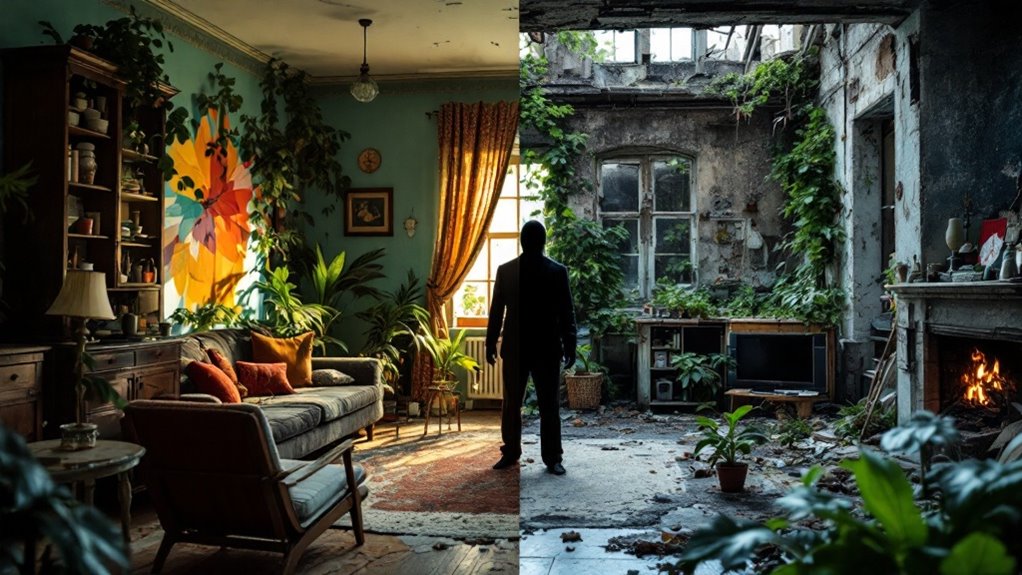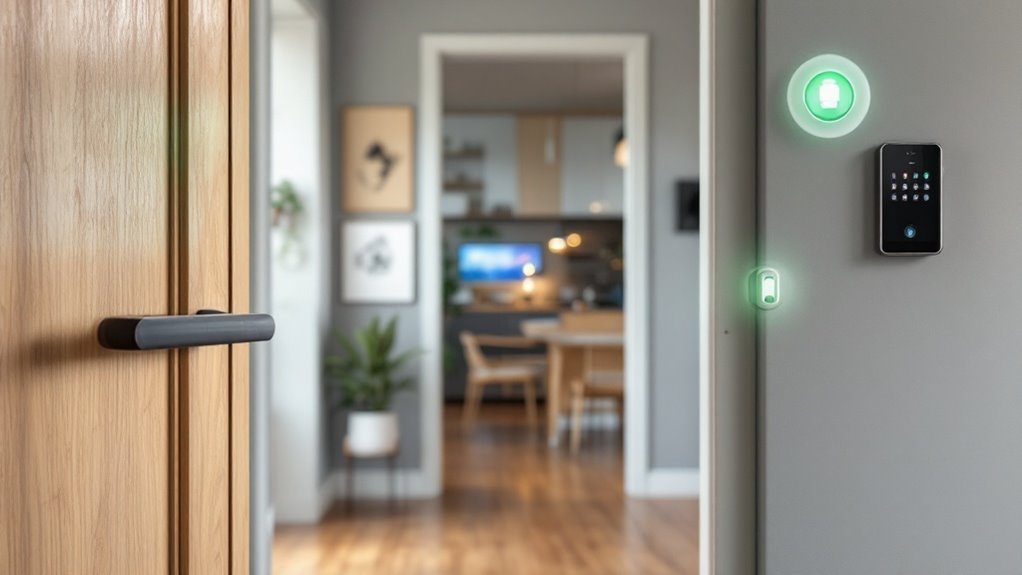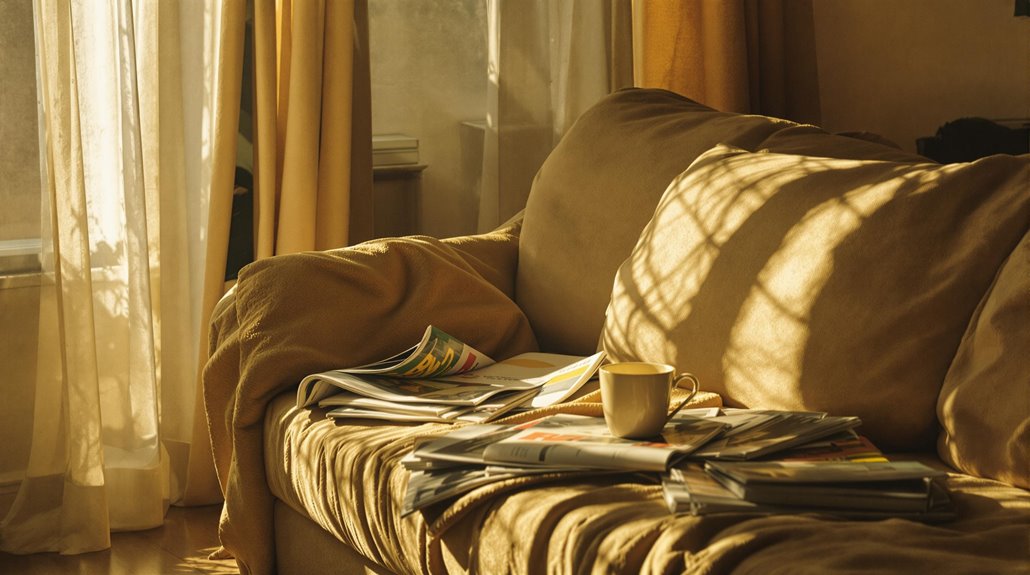Phrogging is when someone secretly lives in your home without you knowing. This illegal activity combines stealthy movements with hacking-like behavior. Phroggers usually hide in rarely used areas like attics or basements and use your resources rather than stealing. Unlike squatters, phrogging remains secretive and short-term, often only revealed through odd signs such as rearranged furniture, tampered locks, or mysterious utility hikes. To prevent it, you can install security systems and regularly inspect your home. If discovered, phroggers face legal consequences for trespassing. There’s a lot more to learn about this eerie phenomenon and how it impacts homeowners.
Key Takeaways
- Phrogging involves secretly living in someone else’s home without their consent, often in hidden spaces like attics or basements.
- It is an illegal act that constitutes trespassing and breaking and entering, with potential criminal penalties.
- Phroggers use the homeowner’s resources but typically do not steal valuables, distinguishing them from burglars.
- Common signs of phrogging include strange noises, rearranged belongings, and unexplained increases in utility bills.
- Phrogging differs from squatting as it is temporary and secretive, while squatting is long-term and assertive.
Definition of Phrogging
Phrogging is the clandestine act of living in someone else’s home or business without their knowledge or consent, usually for a temporary period. The term “phrogging” cleverly merges “frogging,” which implies moving from place to place, with “phreaking,” a term associated with hacking telephone systems. This unusual activity involves individuals, known as phroggers, who discreetly occupy spaces within a property, typically avoiding detection and confrontation.
Phroggers are known for their preference to utilize spaces seldom frequented by the property owners. Common hiding spots include attics, basements, and rooms that see little use. They aim to remain unnoticed, often surviving by consuming easily accessible resources like food and toiletries rather than stealing high-value items. This behavior is not just an unsettling breach of privacy; it’s illegal and falls under several criminal categories. Acts of phrogging involve breaking and entering, trespassing, and potentially other crimes, depending on the extent of the intrusion and the intent behind it.
While the motivation behind phrogging can vary, the intent to temporarily reside without permission remains central to its definition. This activity requires a high level of stealth and planning, as phroggers must guarantee they leave no trace of their presence to avoid detection. The secretive nature of phrogging adds a layer of complexity, making it a subject of intrigue and concern for both property owners and law enforcement. Understanding the definition of phrogging is essential for recognizing the potential risks and legal implications associated with this covert behavior.
Historical Context
You’re likely to find that the term “phrogging” took root in the public lexicon around 2006, popularized by the YouTube series “Living with Strangers.” While the concept isn’t new, its awareness evolved considerably due to media coverage of bizarre cases, such as a woman living in George Michael’s home. This phenomenon not only highlights the origins of the term—combining the idea of “frogging” or moving stealthily with “squatting”—but also underscores its connection to broader societal issues like homelessness and financial hardship.
Origins and Terminology
Although it may seem like a novel concept, the practice of phrogging has roots that intertwine with historical movements and technological subcultures. The term “phrogging” merges “frogging,” meaning moving from place to place, with “phreaking,” a reference to hacking telephone systems. This combination highlights the practice’s transient nature and its affinity with exploiting vulnerabilities, much like digital hackers. Historically, phrogging reflects a psychological inclination to inhabit spaces unnoticed, capitalizing on the vulnerabilities of occupied environments.
The concept gained traction with the 2006 YouTube series “Living with Strangers,” which showcased individuals secretly residing in others’ homes. This series brought phrogging from the shadows into public consciousness, illustrating a blend of desperation and opportunism. Often, individuals engage in phrogging due to homelessness or personal crises, seeking shelter in unoccupied homes or properties. This act draws a parallel to the ways hackers infiltrate systems, further cementing its connection to subculture roots.
Despite its rarity, phrogging has captured media attention through high-profile cases, revealing its emotional and legal ramifications. These incidents underscore the invasive nature of phrogging, prompting discussions about its impact on unsuspecting homeowners and the broader implications for privacy and security.
Evolution in Awareness
As the term “phrogging” emerged into public awareness, its portrayal in media began to shift perceptions and highlight its implications. Initially popularized by the 2006 YouTube series “Living with Strangers,” phrogging introduced viewers to the peculiar concept of individuals secretly residing in others’ homes. Prior to this, similar incidents were often relegated to the domain of urban legends, lacking a framework for understanding their legitimacy.
High-profile incidents further elevated public consciousness. In 2012, the case of a woman living unnoticed for four days under musician George Michael’s floorboards garnered significant media coverage, drawing attention to the reality and potential risks of phrogging. This exposure prompted a reexamination of other unexplained occurrences and contributed to a broader dialogue about home security.
Social media and online platforms have been instrumental in spreading awareness by allowing individuals to share personal experiences and encounters with phroggers. These narratives have helped clarify the distinction between phrogging and squatting; phrogging is now recognized as a temporary, clandestine activity, unlike the more permanent occupation associated with squatting. As awareness continues to evolve, society’s understanding of phrogging’s implications grows, influencing both personal vigilance and media portrayal.
Differences From Squatting

Phrogging and squatting, while both involve occupying spaces without the owner’s knowledge or permission, differ significantly in their execution and intent. When it comes to phrogging, you’re dealing with a secretive and temporary habitation style. Phroggers slip into occupied homes, often aiming to stay undetected and planning to leave before their presence is noticed. In contrast, squatting involves a longer-term occupation of properties that are typically abandoned or unoccupied, with squatters often seeking to assert legal rights through adverse possession.
Consider these key differences:
- Duration and Intent: Phrogging is temporary and opportunistic, targeting homes that are momentarily unmonitored. Squatters, however, may aim for permanence, occupying vacant properties with the intent to eventually claim legal rights.
- Legal Implications: Squatting can sometimes be protected under local laws if squatters meet certain criteria for adverse possession. Phrogging, on the other hand, doesn’t offer such protections. Phroggers are classified as intruders and can be removed without the possibility of legal claims.
- Target Properties: Phroggers infiltrate currently occupied spaces, often when the residents are away, whereas squatters look for places that have been neglected or abandoned.
In essence, phrogging is marked by a lack of permanent residence and a focus on stealth. Squatters, in contrast, often pursue a path toward legal recognition of their occupancy. Understanding these distinctions is essential when examining how each group interacts with property laws and the spaces they occupy.
Common Signs of Phrogging
Detecting phrogging can be challenging, but there are several telltale signs that may suggest someone is secretly occupying your home. Strange noises, especially at night or from parts of the house you don’t often visit, could hint at the presence of a phrogger. These sounds might be subtle, such as footsteps, whispers, or the creaking of floorboards, and are often dismissed as the house settling or typical nighttime sounds.
Another indicator is the frequent disappearance or repositioning of household items. If you notice consumables like food and toiletries vanishing faster than usual, it’s possible someone unauthorized is helping themselves. Even minor changes, like a misplaced book or a different arrangement of your belongings, could be significant.
Pets are often sensitive to unusual activity. If your pet becomes unusually alert or agitated, it might be reacting to an unfamiliar presence. Animals have heightened senses and can detect things humans might overlook.
Signs of disturbance in the home, such as open cabinet doors, rearranged furniture, or tampered locks and windows, could also indicate covert habitation. These disturbances suggest someone is moving through your space without your knowledge.
Lastly, an unexplained increase in utility bills might point to additional, hidden occupants. Phroggers use resources like electricity, water, and gas, which can lead to higher consumption and unexpected charges on your bills.
Prevention and Security Tips

To effectively safeguard your home against phrogging, start by implementing robust security measures. A thorough approach involves leveraging technology and community vigilance to deter unauthorized occupants. Begin by installing home security systems equipped with motion detectors and cameras. These systems not only monitor activity but also act as a deterrent for potential phroggers, reducing the risk of intrusion.
Consider the following steps to enhance your home’s security:
- Reinforce Entry Points: Regularly change locks and reinforce doors and windows, especially during tenant changes or when the property is unoccupied. This prevents unauthorized access and guarantees that only trusted individuals have entry.
- Utilize Outdoor Lighting: Install motion sensor lights around your property. Adequate lighting illuminates potential hiding spots, making your home less appealing to those attempting to remain unnoticed, consequently serving as an effective deterrent.
- Conduct Property Inspections: Regularly inspect your home, focusing on less visible areas like attics and basements. This helps identify any signs of unauthorized habitation early, allowing you to address issues swiftly.
Engaging in neighborhood watch programs can also play a crucial role in preventing phrogging. These programs foster a sense of community awareness, encouraging neighbors to communicate about any suspicious activities. By collaborating with others in your area, you create a network of vigilant individuals who can report unusual occurrences, further bolstering your home’s security.
Legal Consequences
If you discover someone illegally occupying your property, they’re likely committing trespassing, which is a criminal offense. Phroggers can face charges that include fines or even imprisonment, depending on the severity and local jurisdiction. It’s crucial to report any such incidents to law enforcement, who can take appropriate legal action against the intruder.
Trespassing and Invasion Charges
While phrogging might seem like an unusual crime, it is fundamentally a form of trespassing, which is illegal and carries significant legal consequences. If you find someone secretly living in your property, it’s important to understand the seriousness of this invasion. Trespassing laws vary by jurisdiction, but generally, the act of unauthorized entry into a private space can lead to substantial legal repercussions for the intruder.
Here are key points to take into account:
- Legal Action: As a property owner, you have the right to report phrogging to law enforcement. They can investigate and potentially charge the intruder with trespassing, leading to possible fines and imprisonment.
- Evidence Collection: To strengthen your case, documenting evidence is essential. Photographs, video footage, and witness statements can serve as significant pieces of evidence when pressing charges.
- Additional Charges: Phroggers might also face charges such as theft or vandalism if any property damage or stolen items are discovered during their stay.
Understanding these aspects is paramount in addressing the legal ramifications of phrogging. By taking prompt action and gathering evidence, you can work towards achieving justice and ensuring your home’s security.
Potential Criminal Penalties
Although phrogging might seem bizarre, it’s a serious crime with significant legal consequences. As a form of trespassing, phrogging can lead to various criminal charges, including breaking and entering, theft, and invasion of privacy. If you’re caught phrogging, you could face fines, community service, or imprisonment. The severity of the penalties largely depends on local laws and the specific circumstances of the offense. For instance, entering a property without permission can be classified as breaking and entering, which carries its own set of legal ramifications.
Victims have the right to report phrogging incidents to law enforcement, triggering potential criminal investigations. You should gather and present evidence such as photographs, video footage, and witness statements to support any legal action. This documentation is vital in building a case against the intruder.
It’s important to note that local laws regarding trespassing vary. Unlike squatters, phroggers don’t establish legal residency rights, meaning they can be removed as intruders without the complexities of eviction processes. Understanding these legal nuances is essential if you wish to pursue action against a phrogger, ensuring that justice is effectively served.
Conclusion
You’ve explored the unsettling world of phrogging, understanding its definition, history, and how it differs from squatting. While some might think it’s an urban myth, the signs and security tips highlight its reality and importance. By staying vigilant and securing your home, you can prevent this intrusion. Legal consequences are serious, reinforcing that it’s not a harmless prank. With awareness, you’re equipped to protect your space and guarantee your peace of mind.




